|
|
|||||||||||||
| HOME | :: | WHAT'S NEW | :: | PROJECTS | :: | SAILING | :: | MAINTENANCE | :: | RESOURCES | |||
| SAILING LOGS :: EQUIPMENT AND STORAGE :: MISCELLANY | |||||||||||||
|
Saturday, June 8 was the
much-anticipated Falmouth, Maine Triton race and rendezvous--an event that had
been in the planning since summer 2001. Heidi and I were very excited
about the event--a fun sail
For a few weeks prior to the race, I had been enduring some good-natured (and basically deserved) ribbing from Nathan on Dasein about how much STUFF was on board Glissando, and how much lower she floated than his own boat. Ours is not a light boat--we are in the process of outfitting for a long cruise, and I have loaded her with four large anchors, chain, books, spare parts, tools, food...you name it. Needless to say, I felt I had to prove that Glissando could hold her own against any boat...especially Dasein! (We call her "the cork" because she floats so much higher than any other Triton I've seen.) In any event, my competitive spirit was roused, and I was excited for the race. Our informal course, designed by Ron, was to take us around Clapboard Island in a counterclockwise direction, observing the government marks along the way and including nearby Cow Island Ledge in the mix as well. At the skippers' meeting, we decided that we would sail the course twice, starting at or around the nun near Jones Ledge (WSW of Clapboard) and finishing just past the daymark on Upper Clapboard Ledge. Then, we'd proceed just into the cove at Clapboard, which was nicely protected from the predicted wind direction, for our cookout and gathering. Please click
here to open a PDF file of the route. You need Acrobat Reader.
On board Glissando, we
were pleased with our performance--speed and tactics--so far, and now it was
obvious that the fight to stay in the #2 position was going to be tough. Valkyrie
was flying downwind, and soon set a whisker pole on her genoa to wing it out to
starboard (we don't have a pole). With Valkyrie to windward and
just behind, we jibed away towards Clapboard as soon as we were past the small
can that marks the northerly extent of Cow Island Ledge. This move served
three purposes: first, if enabled us to continue sailing favorable angles,
since dead downwind is not very fast in most cases, particularly without a means
of poling the genoa out to windward. Also, we needed to end up closer to
Clapboard anyway, as our next "mark", so to speak, was the tip of the
island. Finally, I wanted to stay out of the way of a fleet of Etchells
and J/24s that were having a "real" race, despite a large part of me
that stubbornly was feeling that our race Closer to the island, we jibed
again onto starboard tack and headed for the tip of Clapboard. As we
converged with the others, We were locked in a close battle with Valkyrie,
with Dasein nipping our heels and Gracie, Grenadier, and E-Ho
II just behind. At the tip of the island, there's always a windless
hole. The key move is to find the perfect sweet spot between staying out
of the hole, and in some wind, and staying as close to shore as possible to sail
the shortest distance. (You can sail nearly up to the rocks--it's a sharp
dropoff.) Valkyrie and Glissando were in more or less the
same position, and we called the line pretty well. Dasein stayed in
just a little closer and lost some wind. Rounding the exposed ledge
beneath the daymarker just off the north tip of the island, Glissando and
Valkyrie were neck in neck, and it looked like the second leg would be
hotly contested. As I trimmed the mainsail in for upwind work, and adjusted
the vang and cunningham, I noticed that something didn't look quite right up at
the tack of the sail. I couldn't immediately put my finger on what was
wrong, but Anyway, what had happened--exactly when I am not sure, but perhaps during our of our downwind jibes, or when I pulled the mainsheet in--was that the old fasteners (SS) holding the track to the mast had failed and sheared off, and a portion of the track had pulled off the mast. Unsure at first what to do, I gave the tiller to Heidi and went forward to inspect the damage. Fortunately, there was no collateral damage, and we were in no danger of any kind. Sadly, though, there was no way to repair the damage and continue immediately in the race. Discouraged--and bummed because it was such a nice sailing day--we retired from the race, probably to the bewilderment of the other contestants who were unaware what had happened. I yelled to Dasein as they sailed by to let them know what happened, and we lowered the sails and proceeded into the cove at Clapboard as an advance reconnaissance team to scope out the mooring situation. After securing the boom with a couple lines, we returned under power to the outside of the island to watch the fleet come by on their second leg and take some additional photos of everybody. (Please click here to see those photos and see the rest of the race and the party that afternoon.)
UPDATE: This repair failed again on the first day of our cruise. I eventually replaced the track with a new section that I modified to fit, and this worked well for the rest of the season. Please see the 2002 cruise logs for more details.
|
|||||||||||||
|
|||||||||||||

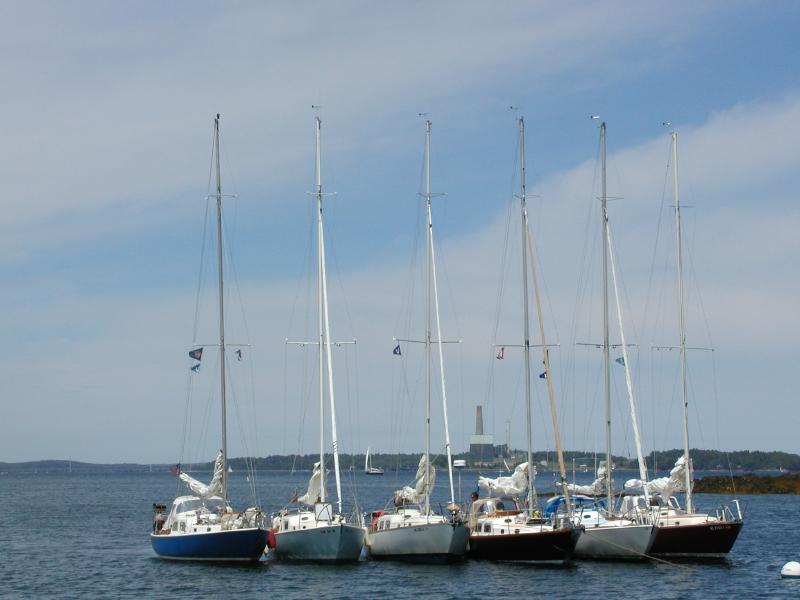 and
cockpit cookout afterwards. We were thrilled when five other Tritons
showed up to attend--a fleet of six, 30+ year
old boats. The participants were:
and
cockpit cookout afterwards. We were thrilled when five other Tritons
showed up to attend--a fleet of six, 30+ year
old boats. The participants were: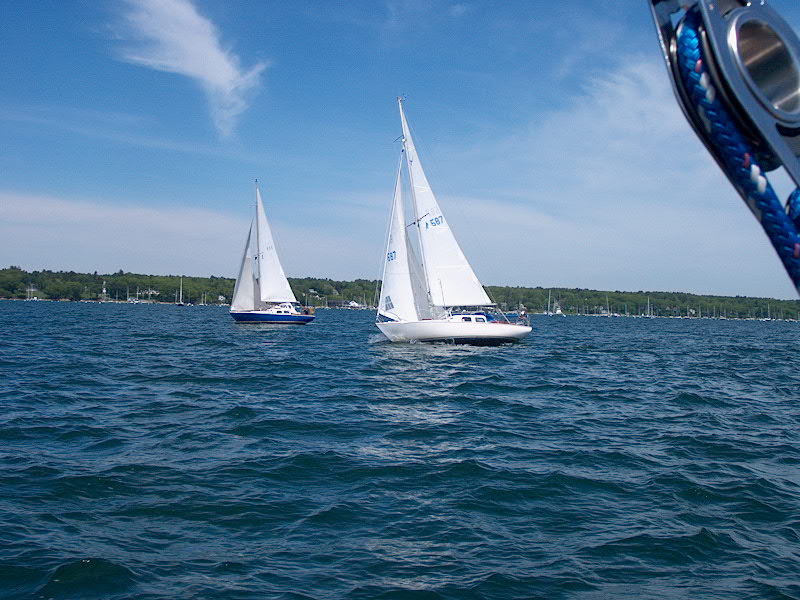 After
leaving the before-race raftup and stowing the docking lines and fenders, we
raised the main and headed towards the start area. Then, we unrolled the
jib and shut down the engine, and spent a few minutes sailing back and forth
while waiting for the other boats to get underway and under sail. After 10
minutes or so, everyone was ready to go and in the general starting area (there
was no formal line or countdown)--and, suddenly, the word was
"GO!" We jibed around quickly and trimmed the sails as we began
the beat to the first mark. The fleet was quite close, and we were in good
position with Valkyrie, E-Ho II, and Grenadier to leeward and just
behind, the rocketship Gracie to windward and sailing fast, Dasein
just ahead and slightly to leeward, and Grenadier also to leeward.
Generally, the boats all seemed pretty evenly matched, speedwise. It was
great fun to see!
After
leaving the before-race raftup and stowing the docking lines and fenders, we
raised the main and headed towards the start area. Then, we unrolled the
jib and shut down the engine, and spent a few minutes sailing back and forth
while waiting for the other boats to get underway and under sail. After 10
minutes or so, everyone was ready to go and in the general starting area (there
was no formal line or countdown)--and, suddenly, the word was
"GO!" We jibed around quickly and trimmed the sails as we began
the beat to the first mark. The fleet was quite close, and we were in good
position with Valkyrie, E-Ho II, and Grenadier to leeward and just
behind, the rocketship Gracie to windward and sailing fast, Dasein
just ahead and slightly to leeward, and Grenadier also to leeward.
Generally, the boats all seemed pretty evenly matched, speedwise. It was
great fun to see!


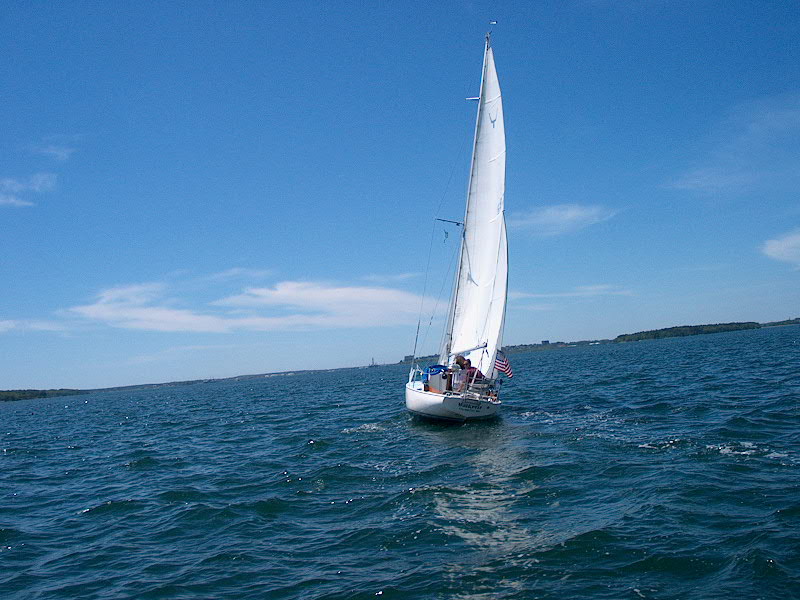 As
soon as we could, we tacked in towards Clapboard, being sure to observe the red
nuns as required. There's almost always favorable wind at the southern tip
of Clapboard, as compared to further out in the space between Clapboard and the
Brothers (a set of small islands), particularly when the southerly wind has as
much of an easterly component as it did on this day. So, there was
everything to gain by tacking in toward shore here--plus, it surely made for a
better VMG towards the mark than continuing on the more southerly heading of
port tack. When we got too close to the ledges inside of the nuns for
comfort, we tacked back onto port, only to have to contend with a J/30 that was
out for a pleasure sail. It was a little frustrating to be obligated by
the rules of the road to stay out of his way...but such is sailing. In any
case, this did not particularly hurt us, and we had already gained significantly
on Dasein, Grenadier, and E-Ho II by our tactical
move. Gracie had stayed in close as well, and was way ahead (in
fairness, she did have a lead when the race was started), and Valkyrie
was also nearby--on one tack, she crossed our bow. Then, we tacked back
onto starboard for another run in, and on our next crossing we were ahead of
her! Heidi was doing a great job trimming the jib on each tack, while I,
my competitive nature getting the best of me, became intense with a desire to
sail as well as possible. (Cruising is just
As
soon as we could, we tacked in towards Clapboard, being sure to observe the red
nuns as required. There's almost always favorable wind at the southern tip
of Clapboard, as compared to further out in the space between Clapboard and the
Brothers (a set of small islands), particularly when the southerly wind has as
much of an easterly component as it did on this day. So, there was
everything to gain by tacking in toward shore here--plus, it surely made for a
better VMG towards the mark than continuing on the more southerly heading of
port tack. When we got too close to the ledges inside of the nuns for
comfort, we tacked back onto port, only to have to contend with a J/30 that was
out for a pleasure sail. It was a little frustrating to be obligated by
the rules of the road to stay out of his way...but such is sailing. In any
case, this did not particularly hurt us, and we had already gained significantly
on Dasein, Grenadier, and E-Ho II by our tactical
move. Gracie had stayed in close as well, and was way ahead (in
fairness, she did have a lead when the race was started), and Valkyrie
was also nearby--on one tack, she crossed our bow. Then, we tacked back
onto starboard for another run in, and on our next crossing we were ahead of
her! Heidi was doing a great job trimming the jib on each tack, while I,
my competitive nature getting the best of me, became intense with a desire to
sail as well as possible. (Cruising is just 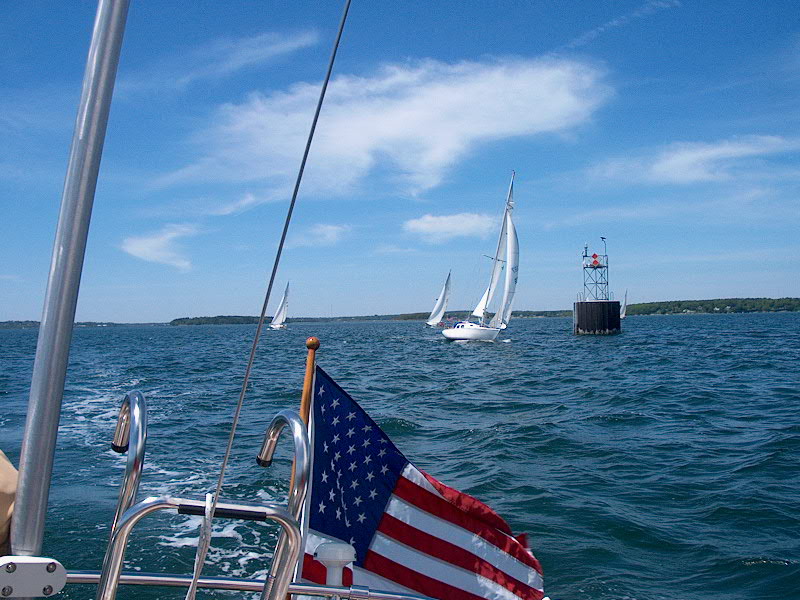 so
much more relaxing...but the racing can be fun from time to time.) At one
point, I tried to steer and adjust the jib, only to allow the boat to come
nearly head to wind (D'oh!) in the process. Finally, we tacked just above
the layline and headed for the monument on Cow Island Ledge. All the boats
were nearby, although Gracie was already 1/4 the way down the next leg.
so
much more relaxing...but the racing can be fun from time to time.) At one
point, I tried to steer and adjust the jib, only to allow the boat to come
nearly head to wind (D'oh!) in the process. Finally, we tacked just above
the layline and headed for the monument on Cow Island Ledge. All the boats
were nearby, although Gracie was already 1/4 the way down the next leg.
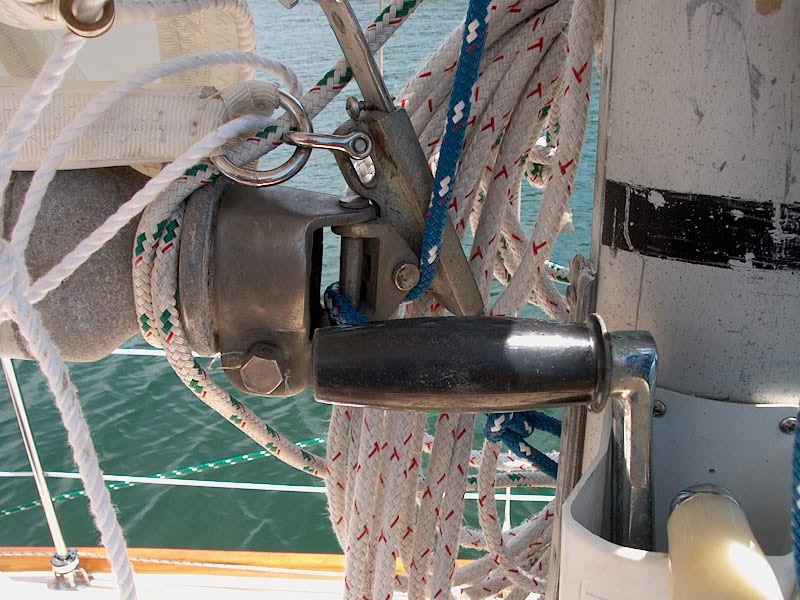 something
was off. Then, almost instantly, I noticed that the gooseneck was
broken! On Glissando, the gooseneck features a length of aluminum
track on the mast, with a bronze car secured to the end of the boom that,
originally, was designed to slide up and down, creating a downhaul. I had
more or less fixed the gooseneck in place last year, as a sliding arrangement
does not work in concert with the solid boom vang.
something
was off. Then, almost instantly, I noticed that the gooseneck was
broken! On Glissando, the gooseneck features a length of aluminum
track on the mast, with a bronze car secured to the end of the boom that,
originally, was designed to slide up and down, creating a downhaul. I had
more or less fixed the gooseneck in place last year, as a sliding arrangement
does not work in concert with the solid boom vang. 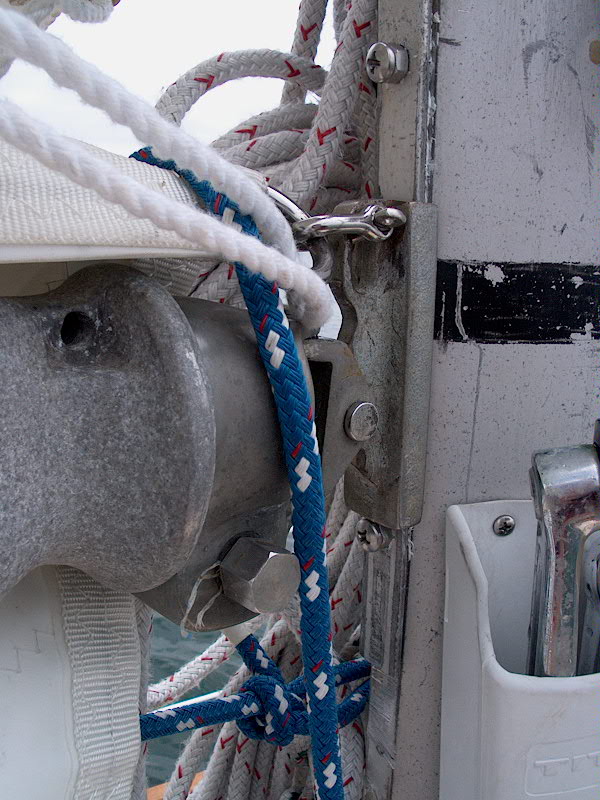 The next day, I returned to the boat
to repair the gooseneck. I had hoped to use a section of 1" aluminum
track that I had around (modern anodized track), but unfortunately the bronze
car was a different size--just a bit too small. What I really need is a
new, proper fixed gooseneck (next year), but for the immediate future I just
needed to fix the thing so I could go sailing. There was still a section
of track attached to the mast, lower than the boom position, that was in fair
condition, so I removed it with a hacksaw (there was no chance of turning the
corroded screws) and squared up a section for reinstallation. I drilled
and tapped for new 1/4-20 stainless steel fasteners, and installed the new track
in place in a bed of polysulfide to minimize direct metal contact and
corrosion. The sawing and drilling left metal filings all over, and I was
happy to give the boat a good scrubbing the next day.
The next day, I returned to the boat
to repair the gooseneck. I had hoped to use a section of 1" aluminum
track that I had around (modern anodized track), but unfortunately the bronze
car was a different size--just a bit too small. What I really need is a
new, proper fixed gooseneck (next year), but for the immediate future I just
needed to fix the thing so I could go sailing. There was still a section
of track attached to the mast, lower than the boom position, that was in fair
condition, so I removed it with a hacksaw (there was no chance of turning the
corroded screws) and squared up a section for reinstallation. I drilled
and tapped for new 1/4-20 stainless steel fasteners, and installed the new track
in place in a bed of polysulfide to minimize direct metal contact and
corrosion. The sawing and drilling left metal filings all over, and I was
happy to give the boat a good scrubbing the next day.